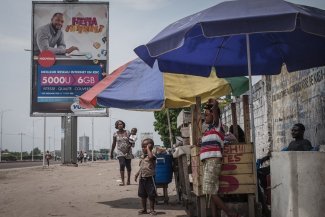
On an otherwise pleasant September day in Istanbul, a brief yet powerful earthquake measuring 5.8 on the Richter scale rumbled throughout Turkey’s largest city, startling anyone who felt the sudden tremors. Though the damage caused was fairly minimal, it was a grim reminder of the monumentally disastrous quake that roared through the Marmara region almost exactly two decades ago, killing 17,000 people.
It also prompted Istanbulites to confront the elephant in the room: it is widely believed that another earthquake with a magnitude of 7 (the threshold of a ‘major’ earthquake) or higher, is expected to wreak havoc upon Istanbul in the near future, in what experts are convinced will result in far greater devastation than the 1999 earthquake, as the city is woefully unprepared for such a catastrophe.
“The most critical factor in Istanbul is unplanned urbanisation, because Istanbul’s urbanisation process has lacked a disaster plan. The ‘gecekondu-ization’ process of Istanbul transitioned from an illegal to legal one,” says Oktay Kargül, secretary of the Istanbul branch of the Chamber of Urban Planners (SPO). The term ‘gecekondu’ roughly translates to ‘built overnight’ and refers to the swathes of informal settlements that popped up across the city following the massive rural to urban migration that began in the 1950s.
Though these neighbourhoods were often built illegally on publicly owned land, many residents were eventually granted partial deeds, official addresses, and were able to benefit from municipal services, thanks to the populist impulses of the era’s political parties who were chasing votes.
Many of these areas eventually developed into more permanent settlements with improved housing stock, while some have been demolished and others have been engaged in protracted legal battles to save their homes and communities.
“Istanbul’s geography consists of hills and naturally-occurring materials and there are settlements in places that we would never think of,” Kargül says. It is not uncommon to see modest, one-storey homes that would look better placed in a village, wedged in between rows of taller, modern apartment blocks. Other informal homes are hidden in plain view, strategically shaded by clumps of trees and other greenery. Though many residents of these neighbourhoods defiantly insist that their homes emerged completely unscathed from previous earthquakes, it is impossible to tell what might happen next time, as the 1999 quake only affected parts of the city (its epicentre was in a neighbouring province to the east).
“One example is the district of Kağıthane, where homes were built over stream beds. In the district of Zeytinburnu, there are buildings that go as far as the coast that were built on ground that is not solid, and very tall buildings were built in sections on very narrow streets,” says Kargül. Some of the Istanbul areas hit hardest by the 1999 quake were the outer suburbs built alongside the Marmara coastline.
In terms of what needs to be done to protect Istanbul, the primary solution is pretty straightforward: “The most essential and correct precaution is to construct buildings that do not collapse,” says Ali Hacıalioğlu, board secretary of the Istanbul branch of the Union of Chambers of Turkish Engineers and Architects.
“We believe that a segment of our current housing stock is unsafe. They are not sturdy, so we need to improve and reinforce these buildings. To do this, there are different methods: you can demolish the building and rebuild it anew, or you can strengthen the building,” Hacıalioğlu tells Equal Times.
A report published by Hacialioğlu’s chamber last year on building inspections highlighted that amongst the problems Turkey faces on this issue is the fact that professional organisations like his are excluded from the construction process, and that building inspection is no longer considered a public service but a commercial matter.
Zoning amnesty, disaster assembly areas and unplanned urbanisation
The government launched its ‘zoning amnesty’ initiative prior to the general elections of 2018; as a result, millions of illegally-built buildings became eligible to be granted legitimate deeds in exchange for a fee paid to state by the owners. Though many people have taken advantage of this opportunity and applied for the zoning amnesty, its implications have already proven disastrous. An apartment building, the top three floors of which were added illegally, collapsed in the district of Kartal earlier this year, killing 21 people. The building was legally formalised under the zoning amnesty policy.
Kargül estimates that in the event of an Istanbul earthquake that reaches 7 or above on the Richter scale, three out of Istanbul’s 16 million people will be affected, as 20 per cent of homes will be completely destroyed while the remaining 80 per cent will experience damage in some capacity.
Another key factor in the potential devastation that could be visited upon Istanbul in the event of a major earthquake is the disappearance of disaster assembly areas. The day after the 5.8 quake in September, Istanbul mayor Ekrem Imamoğlu said that out of 470 disaster assembly areas that had been designated after the 1999 earthquake, only 77 remained, as many have been built over by malls or other structures. The city desperately lacks parks and green spaces, and many Istanbulites are unsure of where to go if an earthquake strikes.
Istanbul Chamber of Civil Engineers chairperson Nusret Tuna confirmed Imamoğlu’s figures, adding that given the size of the city’s population, even thousands of assembly areas would be insufficient.
In terms of Istanbul’s unplanned urbanisation, informal settlements are only one part of the story. It is widely believed that a significant percentage of the city’s housing stock was built using poor-quality materials. This was even acknowledged by Ali Ağaoğlu, an infamous contractor whose name is emblazoned in huge letters across the massive residences his company has built, and who is synonymous with some of the unbridled development that has plagued Istanbul.
In a 2009 interview, Ağaoğlu said that his company and others used sand sourced from the Marmara Sea and iron purchased from scrapyards to build apartments in the 1970s, claiming that this was the best material available at the time. “If there’s an earthquake, the army won’t even be able to enter Istanbul. The dead will be the lucky ones,” Ağaoğlu said, claiming that at least 70 per cent of the city’s housing was not earthquake-proof.
Legislation and hope for the future
Even legislation supposedly concerning the rehabilitation of at-risk areas has potentially exacerbated the problem. Law 6306, known as the ‘law for the transformation of areas under risk of disaster’ has been in effect since 2012 and has enabled the demolition of poor, informal neighbourhoods, which are swiftly replaced by shiny new residences.
“6306 is very, very far off from its starting point. Nowadays it has opened the doors for people to build housing and create commercial spaces. The law is left in the hands of many people outside the control of the state and unfortunately we cannot follow up on the supervision of the work that is being done there,” says Kargül, mentioning the run-down, working-class neighbourhood of Fikirtepe, the site of one of the city’s most notorious gentrification projects.
Fikirtepe was declared at-risk in 2013, enabling numerous contractors to swarm in and quickly demolish many of the area’s shabby homes in order to build luxury waterfront apartments. But a number of people were unwilling to sign over their homes to the contractors, often hoping to get a better deal than what was offered, while other companies went out of business amidst a flailing Turkish economy where the construction sector has been severely impacted, resulting in stalled projects and hundreds of livid residents whose lives have been upended. The fiasco remains unresolved, and it is among the biggest urban disasters currently unfolding in Istanbul today.
Istanbul’s speedy, unchecked development predates President Recep Tayyip Erdoğan’s Justice and Development Party (AKP) by decades. But 15 years of the party’s administration has pushed the city to its absolute limits, and voters opted this year for a change, electing Mayor Imamoğlu of the main opposition Republican People’s Party (CHP) not once, but twice after the government cancelled the results of the first election.
“It’s a new beginning, a new mayor with high energy who himself has said that these issues need to take priority on the agenda. We hope that this will be the case,” says Kargül of Imamoğlu, who has vowed to work on taking serious precautions.
In October, Imamoğlu said that his administration intended to reinforce 20,000 buildings a year, while preparing more than 800 new disaster assembly areas with a collective capacity of 21 million people.
However, following the September earthquake, Imamoğlu claimed that he did not receive an invitation to a government-led meeting regarding the earthquake, prompting a flurry of squabbling in opposing political circles, and echoing the sad reality that even major natural disasters may not be a uniting force in a divided Turkey.








